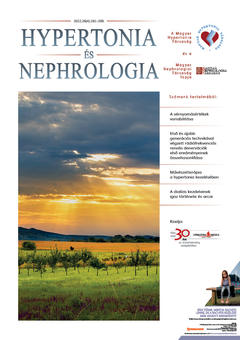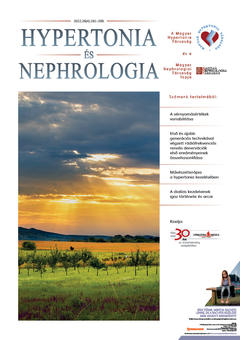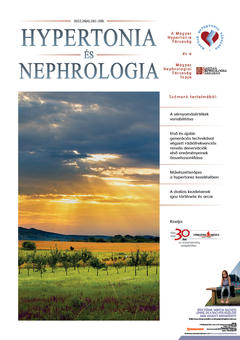The eLitMed.hu medical portal uses computer cookies for convenient operation. Detailed information can be found in the Cookie-policy.
Hypertension and nephrology - 2022;26(04)
Content
[What do we need to know about blood pressure variability]
[Circadian (within 24hs), medium (days) and long-term (weeks, months, years) and seasonal, regional changes and fluctuations in blood pressure have long been known in both normotensive and hypertensive patients as well. It is also known to have higher fluctuations in more severe hypertensives and the elderly. In the last decade and nowadays, the variability of blood pressure has been given new light and a number of factors influencing fluctuation and its consequences have been analyzed in detail. True diagnostic, prognostic value and role in assessing the success of antihypertensive therapy come to the fore. In parallel, measurement methods have been re-evaluated and the standardization of index valuation has begun. Beat-to-beat variability is primarly a part of the scientific research. Measurement and evaluation of short-term blood pressure variability with ambulatory blood pressure monitoring be considered a solution, although some progress has been made. Incorporating medium and long-term variability into everyday clinical practice has become increasingly important by standardizing methods and indices for measuring blood pressure at home and doctor’s office. In our article, we show that elevated blood pressure variability (and its indexes) clearly predict subclinical (asymptomatic) structural and functional changes, as well as cardiovascular-renal clinical events and adverse outcomes. In the treatment of hypertension, the reduction of blood pressure variability plays a crucial role in assessing the true value of success, in addition to the target blood pressure achieved. Based on our own experience and literature data, it is now rightly suggested that reducing blood pressure variability should be a second therapeutic goal in the future and that this should be emphasized in the guidelines for hypertension as well.]
[Variability of blood pressure values]
[Blood pressure is not a fix value, it can differs from beat-to beat. Not known, which of the repeated measurements represents the danger to the cardiorespiratory system. Most of the authors propose to decide the therapy according to the variance – not the simple mean – of the measured, optimally 6-7 systolic pressure value. Over ABPM any instrument in the office calculating means and variance of the systolic/diastolic pressures should give additional informations for the better treatment of patients.]
[Comparison of first results of radio frequency renal denervations with first and newer generation techniques]
[A form of renal denervation, when using radiofrequency technique, thermal energy destroys the nerve-fibres around the renal artery. The Symplicity FlexTM was the first such catheter, an improved new generation version of it the Symplicity SpyralTM catheter. In the Albert Szent-Györgyi Health Center of the University of Szeged, renal denervations were performed with both devices in hypertensive patients whose blood pressure could not be reduced to the goal range with multiple antihypertensive combinations. With the first catheter, only the main artery at 4-5 points per side, with Symplicity SpyralTM catheter already the segmental small branches together with the main artery can and should be ablated at least 16-18 or more points per side. Not with the old method on the University of Szeged, but with the new method, the first patient managed to achieve the systolic target blood pressure, while the number of antihypertensives also decreased significantly. Vascular complications did not occur in either case of interventions. Our first result with the Symplicity SpyralTM catheter according to the new method supports the view that more accurate ablation and preferably distal ablation can lead to more effective and permanent blood pressure reduction.]
1.
Clinical Neuroscience
Is there any difference in mortality rates of atrial fibrillation detected before or after ischemic stroke?2.
Clinical Neuroscience
Factors influencing the level of stigma in Parkinson’s disease in western Turkey3.
Clinical Neuroscience
Neuropathic pain and mood disorders in earthquake survivors with peripheral nerve injuries4.
Journal of Nursing Theory and Practice
[Correlations of Sarcopenia, Frailty, Falls and Social Isolation – A Literature Review in the Light of Swedish Statistics]5.
Clinical Neuroscience
[Comparison of pain intensity measurements among patients with low-back pain]1.
Clinical Neuroscience Proceedings
[A Magyar Stroke Társaság XVIII. Kongresszusa és a Magyar Neuroszonológiai Társaság XV. Konferenciája. Absztraktfüzet]2.
3.
Journal of Nursing Theory and Practice
[A selection of the entries submitted to the literary contest "Honorable mission: the joys and challenges of our profession" ]4.
Journal of Nursing Theory and Practice
[End of Life and Palliative Care of Newborns in the Nursing Context]5.
Journal of Nursing Theory and Practice
[Aspects of Occupational Health Nursing for Incurable Patients ]






